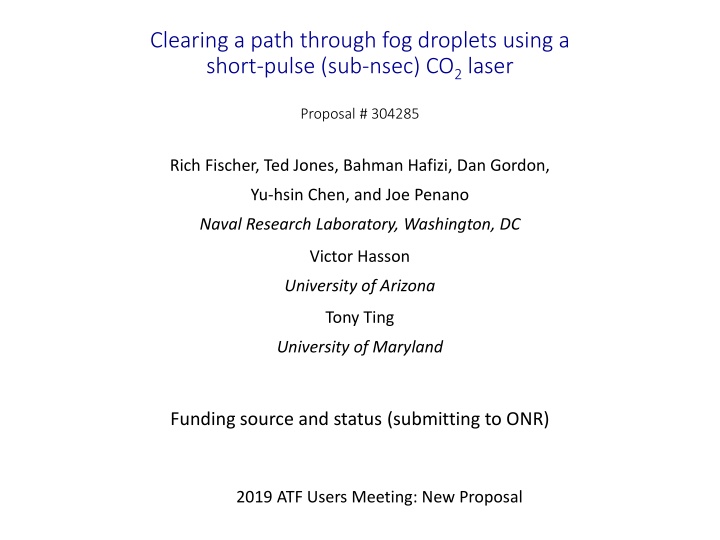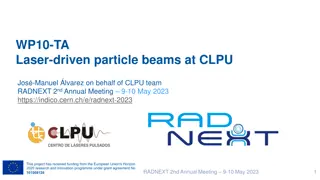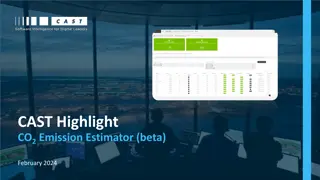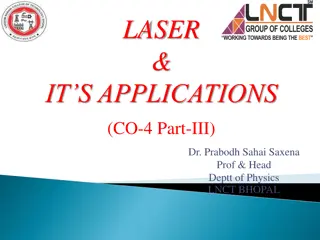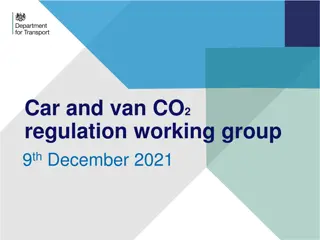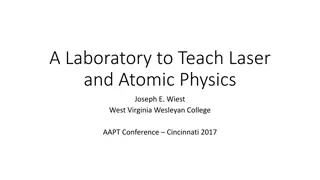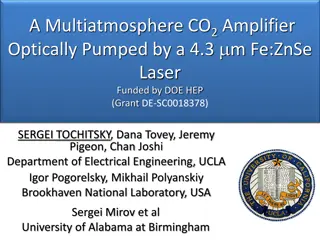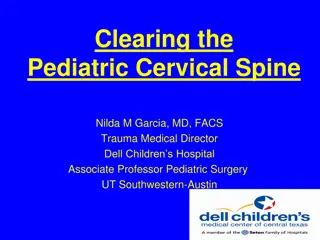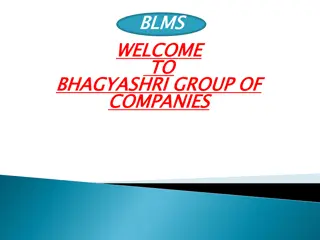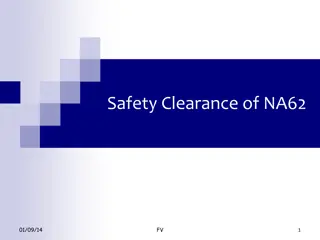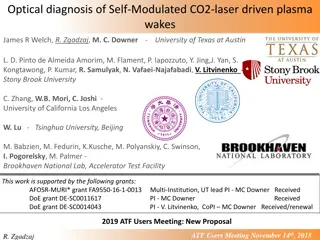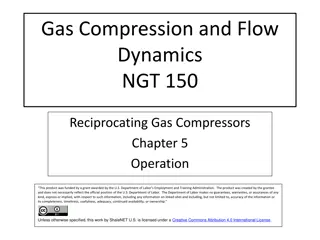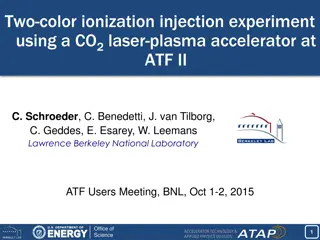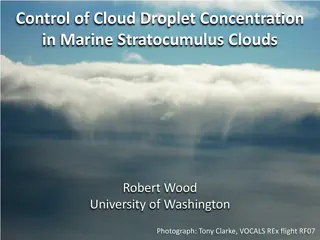CO2 Laser for Fog Droplet Clearance
Using short-pulse CO2 laser technology, this proposal aims to vaporize and shatter fog droplets efficiently to improve visibility in foggy conditions. The scientific case, laser transmission through water droplets, benefits of short-pulse laser shattering, and past experiments provide insights into the potential applications of this innovative approach.
Download Presentation

Please find below an Image/Link to download the presentation.
The content on the website is provided AS IS for your information and personal use only. It may not be sold, licensed, or shared on other websites without obtaining consent from the author.If you encounter any issues during the download, it is possible that the publisher has removed the file from their server.
You are allowed to download the files provided on this website for personal or commercial use, subject to the condition that they are used lawfully. All files are the property of their respective owners.
The content on the website is provided AS IS for your information and personal use only. It may not be sold, licensed, or shared on other websites without obtaining consent from the author.
E N D
Presentation Transcript
Clearing a path through fog droplets using a short-pulse (sub-nsec) CO2laser Proposal # 304285 Rich Fischer, Ted Jones, Bahman Hafizi, Dan Gordon, Yu-hsin Chen, and Joe Penano Naval Research Laboratory, Washington, DC Victor Hasson University of Arizona Tony Ting University of Maryland Funding source and status (submitting to ONR) 2019 ATF Users Meeting: New Proposal
Scientific Case Laser vaporization and shattering of fog droplets IR radiation is strongly absorbed by liquid water (but weakly absorbed by atmospheric gasses) - Water at = 10 um, L = 10 um - Water at = 3 um, L = 1 um Typical fog droplets: 1-30 um diameter, 0.1 g/m3 mass loading, -65 dB/km extinction IR lasers can be used to vaporize and explosively shatter fog droplets - slow heating: vaporization, cw lasers [1] - fast heating: vaporization + shattering, shock waves, hot spots, superheat limit (305 deg C) [2] Droplet scattering can shift from Mie regime to Rayleigh less scattering along path - large droplets, Mie ~ a2 - small droplets, Rayleigh ~ a6 / 4 Shattering experiments using pulsed IR lasers - long pulse (20 usec) - moderate pulse lengths (80 400 nsec) [1] Mullaney et al., Fog dissipation using a CO2 laser, Appl. Physics Letters, 1968. [2] Kafalas and Ferdinand, Fog droplet vaporization and fragmentation by a 10.6-um laser pulse, Appl. Optics, 1973. 2
Laser transmission through a single water droplet Droplet diameter = 53 um SLM CO2 laser 80 nsec pulse length 650 mJ 50 um FWHM at focus Droplet shatter threshold intensity = 20 MW/cm2 At 1 GW/cm2 laser-induced gas breakdown Transmission improves as laser intensity increases Kwok et al., Enhanced transmission in CO2-laser-aerosol interactions, Optics Letters, 1988. 3
Benefits of short-pulse (sub-nsec) laser-droplet shattering Reduced energy to shatter droplet (~ J/cm2) Longer cleared path Improved transmission Faster shattering (use a train of pulses?) Nonlinear channeling of short IR laser pulses (balance diffractive spreading) Evaluate ultrafast absorption and heating of liquid water (non-thermal) 4
Past Experiment at NRL cw vaporization of aerosols Scattering Diagnostics Beam Dump Aerosol Generator L = 100 cm ID = 10 cm Aerosol Flow (down) 16 um dia 700 droplets / cm3 1.07 um, 2 kW CW Heater Laser Aerosol Sizer 0.3 20 um dia CW Probe Laser 0.53 um, 100 mW filter Fischer et al., Absorption and scattering of 1.06 um laser radiation from oceanic aerosols, Appl. Optics 48, 2009. 5
BNL Experiment short-pulse (sub-nsec) shattering of water droplets CW Probe Laser Pulsed CO2 Laser LWIR, MWIR, SWIR, visible Aerosol Flow (down) Aerosol Generator L = 100 cm ID = 10 cm Scattering Diagnostics Aerosol Sizer 0.3 20 um dia Beam Dump Use collimated beam through interaction tube 6
Program Plans droplet shattering using OPA Pulse length 50 fs - psec NRL Topas OPA laser Perform single-droplet shattering experiments at different IR wavelengths 7
Program Plans droplet shattering using IR lasers Year 1 Quarter Vary aerosol parameters at NRL Test probe lasers and diagnostics 1-2 Conduct laser-aerosol tests at BNL Modify set-up as needed 3-4 Year 2 Generate single droplets at NRL Shatter single droplets using OPA laser 1-4 8
CO2 Laser Requirements The following options are available at the laser source. OPTION 1 (full power, ~1 shot per minute) isotopic gas in final amplifier 2 TW max (2 ps, 4 J, single pulse) 9.25 um M^2 ~ 2 linear polarization OPTION 2 (regen only, 1.5 or 3 Hz) 3 GW max (2 ps, 6 mJ) 9.25 um M^2 ~ 1.5 linear polarization (circular available at slightly reduced power) ** Please note any specialty laser configurations here ** Pulse length: 60 psec (2 psec) Vary fluence ~ J/cm2 Beam diameter ~ few cm Interaction Point location: Laser room 9
2019 Experiment Time Estimates Run Hours (include setup time in hours estimate): Number of CO2laser hours delivered to laser experiment hall ( FEL room ): 120 hours Overall % setup time: 20% Hazards & installation requirements: Large installation (chamber, insertion device etc ): N Laser use (other than CO2): Yes Cryogens: N Introducing new magnetic elements: N Introducing new materials into the beam path: N Any other foreseeable beam line modifications: N Please describe further where necessary Possible probe lasers for aerosol shattering experiments - LWIR (9-11 um) - SWIR (1.5 um) - visible (0.5 um) 10
Scientific Case Laser vaporization and shattering of fog droplets Kafalas and Ferdinand, Fog droplet vaporization and fragmentation by a 10.6-um laser pulse, Appl. Optics 12 (1973) 12
Scientific Case Laser vaporization and shattering of fog droplets 13
Scientific Case Laser vaporization and shattering of fog droplets = 147 W / km W = 0.1 g/m3 typical fog mass loading = 14.7 x 4.34 = 63.8 dB/km agrees with measurements fog mass loading can be higher than 0.1 g/m3 mass loading often increases with altitude (NASA aircraft measurements) V. Chimelis, Extinction of CO2 laser radiation by fog and rain, Appl. Optics, 1982. 14
